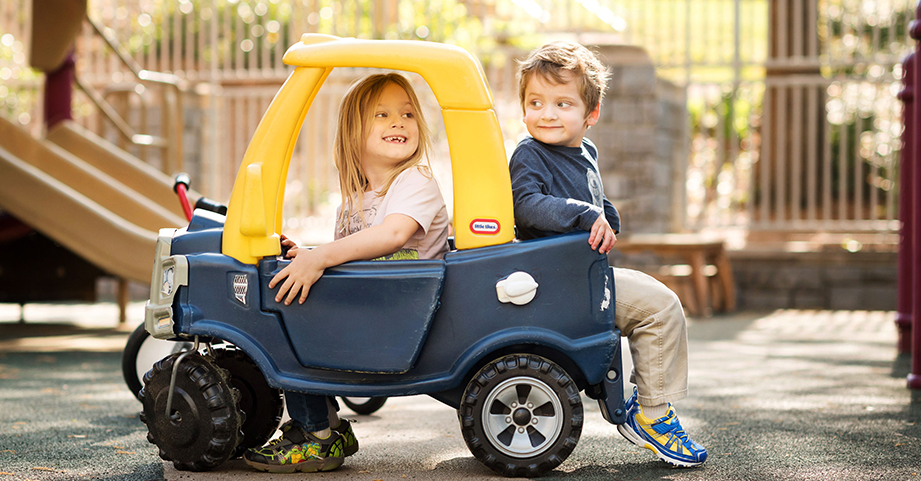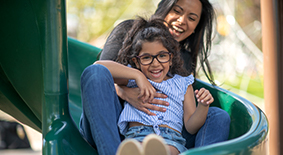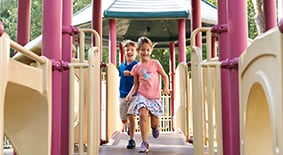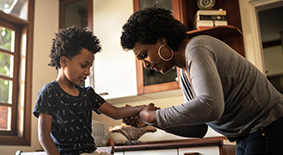Preventing Broken Bones in Babies, Children and Teens
At Children’s Healthcare of Atlanta, we understand broken bones (also called fractures) in babies, children and teens because we treat more of them than any other hospital in Georgia. We have a few tips that parents can use to prevent these types of orthopedic injuries from happening to their children.
Toddlers are always busy practicing their new abilities of walking, running, climbing and jumping. When combined with playground fun on monkey bars, slides and trampolines, the risk for falls and broken bones increases. Even infants, though they can’t yet walk or run, can fracture their bones.
Jill Flanagan, MD, a Pediatric Orthopedic Surgeon at Children’s, says, “Broken bones are common in childhood but sometimes can be more difficult to identify in infants or toddlers. They can’t point to the limb that hurts, and sometimes the X-rays may not show the fracture at first. But with the experience and expertise of our pediatric orthopedic team, a careful exam will often localize where the injury has occurred.”
But as the old saying goes, an ounce of prevention is worth a pound of cure. Anticipating the places that may be dangerous for your child can help prevent falls, bumps and, ultimately, broken bones. Here are some tips to keep your little ones safe from broken bones.

Tips for toddlers
- Use a car seat or booster seat every time your child rides in a car or other vehicle.
- Be sure your windows won’t open more than 4 inches by securing with guards or window stops. Young children can manage to fall out of a window that’s only open 6 inches.
- Supervise your child closely, especially on a balcony or porch or in the bathtub.
- Place safety rails on your child’s bed. Put a nightlight in the child’s room for extra security.
- Install child safety gates at the top and bottom of stairs to avoid falls. Place doorknob covers on doors that lead to a flight of stairs, such as a basement door.
- Put your child in the proper seat in a shopping cart, and use the safety belt.
- Try to find playgrounds with a cushy surface, like mulch, rubber or sand, rather than a hard surface.
- Make sure your child wears a helmet and safety gear when she starts to ride a bike or scooter.
- Do not place toddlers down slides with adults—their feet can get stuck, causing injuries.
Tips for infants
- Use a secure car seat when your baby is riding in a vehicle.
- Don’t place infant carriers on a counter or table; put them on the floor.
- Use the safety strap on high chairs and changing tables.
- Don’t leave your child alone—even for a second—when she is on a high surface, like a bed, sofa, chair or changing table.
- Avoid baby walkers; they can cause falls. Instead, opt for an activity center like an exersaucer or a bouncer that cannot roll.
- Choose a stroller that is sturdy and will not tip easily.
Face it—most kids and teens don’t sit still very much. They ride bikes through the neighborhood, play soccer and football, jump rope, climb trees and do tricks on their skateboards.
Healthy activities like these are a big plus for kids. But these types of activities can sometimes cause a fall and even a broken bone. How can you help your child or teen avoid fractures?
Here are some tips from the orthopedics team at Children’s:
- Serve your child foods rich in calcium and vitamin D, which keep bones strong. Some good sources are milk, yogurt, cheese, nuts and seeds. The recommended daily dosage of vitamin D is 600 IU, and for calcium, it’s 1,000 to 1,300 milligrams. Vitamin and calcium supplements designed for children can also help meet your child’s needs.
- Encourage your child to be active. Regular physical activity can help keep bones strong too.
- Be sure your child or teen uses the right safety equipment, such as helmets and protective pads, when playing sports. Equipment should fit properly, or it may not do its job.
- When riding in a car or other motor vehicle, everyone should always wear a seatbelt. Younger children need a car seat or booster seat, too. If your child zooms around on a bike or scooter, enforce a helmet rule.
- Indoors, keep your stairways clear of objects that a child (or a parent) could trip over.
- Falls happen. Teach your child how to fall correctly. Most people stick their arms straight out and try to catch themselves with their hands. This can lead to a broken wrist or elbow. Instead, falling on the forearms and rolling can reduce the risk of a broken bone.
- Take precautions when playing on trampolines. Make sure the trampoline has the proper net, that the springs are covered, and that only one child jumps on the trampoline at a time.
Weekend Clinic for Injuries
Sprains, strains and broken bones don’t wait for weekdays. If your child needs to see a pediatric orthopedic expert on a weekend, Children’s has appointments available on Saturdays in Sandy Springs and Sundays in Duluth. Make an appointment online or call 404-255-1933 to schedule.
Make an AppointmentJill C. Flanagan, MD, is an Orthopedic Surgeon at Children’s Healthcare of Atlanta. She is trained in advanced techniques and technologies, such as using the Taylor Spatial Frame, TL-Hex frame and Precice nail. Her expertise in limb lengthening has led to invitations from the Baltimore Limb Deformity Course to teach others how to perform limb-lengthening surgeries.
This content is general information and is not specific medical advice. Always consult with a doctor or healthcare provider if you have any questions or concerns about the health of a child. In case of an urgent concern or emergency, call 911 or go to the nearest emergency department right away. Some physicians and affiliated healthcare professionals on the Children’s Healthcare of Atlanta team are independent providers and are not our employees.
Contact Us 404-255-1933



